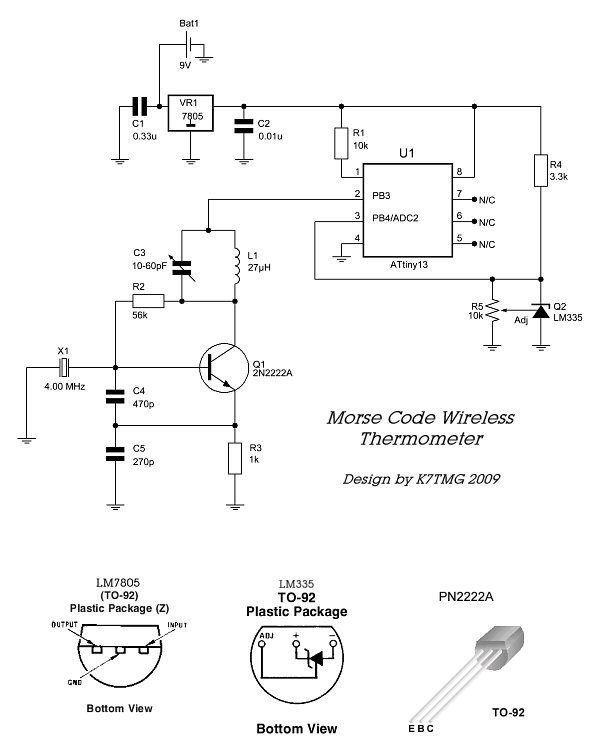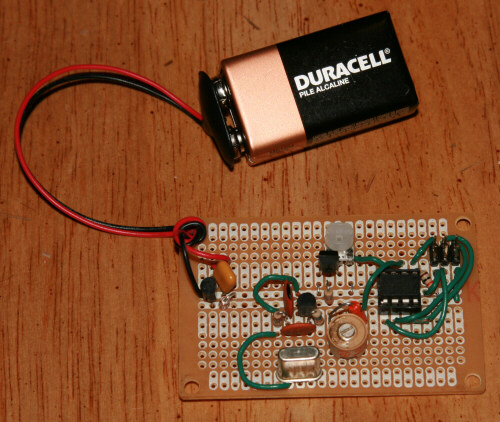Do you enjoy CW rag-chewing like me? Chances are that if you do, you'll often mention the weather during the QSO and perhaps you send the local temperature?
I often send something like this "FB UR WX = HR WX SUNNY TEMP ABT = = = " as I am trying to quickly guesstimate the actual outside temperature - Darn I forgot to check the thermometer before getting on the air. Happens every time....
... But no more! ...
This project actually came to life after a fairly expensive commercial wireless thermometer bit the dust. It had been a pain ever since I stumped up the $39 at a large home improvement franchise. It ate batteries, refused to communicate and finally shorted out causing it's own temperature (and mine!) to rise significantly.
So, always conscious of the "true ham spirit" I decided I would make my own but this one wouldn't try to communicate with an indoor display using 432MHz and FM data but directly to my ears on HF and in CW too! So now all I have to do is tune my main rig before the QSO and listen to the current temperature without venturing outside!
Background
Fortunately at least in the USA the FCC has seen fit to address the issue of low-power non-licensed transmitters in their Part 15 regulations. The bit that interests us for this project can be found in their OET Bulletin No.63 ("Understanding the FCC Regulations for Low-Power, Non-Licensed Transmitters") and I summarize here:
Home-Built Transmitters that are Not for Sale
Hobbyists, inventors and other parties that design and build Part 15 transmitters with no intention of ever marketing them may construct and operate up to five such transmitters for their own personal use without having to obtain FCC equipment authorization. If possible, these transmitters should be tested for compliance with the Commission�s rules. If such testing is not practicable, their designers and builders are required to employ good engineering practices in order to ensure compliance with the Part 15 standards.
Home-built transmitters, like all Part 15 transmitters, are not allowed to cause interference to licensed radio communications and must accept any interference that they receive. If a home-built Part 15 transmitter does cause interference to licensed radio communications, the Commission will require its operator to cease operation until the interference problem is corrected. Furthermore, if the Commission determines that the operator of such a transmitter has not attempted to ensure compliance with the Part 15 technical standards by employing good engineering practices then that operator may be fined up to $10,000 for each violation and $75,000 for a repeat or continuing violation.
Looking through these regulations it becomes apparent that a very low power HF transmitter can be employed on a wide range of frequencies for personal use.
To help ensure "good engineering practices" this project uses a small tuned HF oscillator, NO PA and NO ANTENNA because we don't need them. My measured range with a sensitive HF radio is about 25 ft. Perfect for in-shack listening. The actual power generated by the oscillator is less than 1 milliwatt so not likely to cause much QRM to anyone, especially operated without an antenna!
On to the good stuff!
At the heart of the project is a miniature computer in a single 8 pin IC. It's the nifty little Atmel ATtiny13 a very low power 8 bit microprocessor with it's own memory, clock, ADC (analog to digital converter) and a variety of configurable output/input pins. Here's one ![]() -small isn't it?
-small isn't it?
The project uses an LM335 temperature sensor connected to an ADC channel on the micro. This sensor provides 10mV per °K (Kelvin) from which corresponding Celsius and Fahrenheit temperatures are easily obtained.
The HF transmitter is really just a collector-tuned Colpitts oscillator using a junk box crystal. In my version I used a cheap 4.00MHz xtal I salvaged from an old computer. The frequency is certainly not critical but probably should be out of the ham bands, just in case you end up having a QSO on that frequency one day and QRM yourself!
The oscillator draws about 1mA of current key-down and is driven directly from one of the output pins on the ATtiny. The collector tuned circuit helps to clean up the waveform and prevent too much RF from getting near the microprocessor. I used a 27uH miniature inductor and a 10-60pF variable trimmer and this should ideally be adjusted using a 'scope to observe output (measure at emitter). Just rotating the trimmer until the oscillator starts reliably is probably enough. Harmonics will be present at very low levels but you might find that by tuning to 8.00Mhz or 12.00MHz a clearer signal will be heard especially at night. You would have to be very close to the oscillator to pick these up but if you situate the thermometer somewhere near your outside antenna it should work just fine. I wouldn't try a xtal fundamental any higher than perhaps 10-12MHz as you will probably have some chirp. You would also need to alter the tuned circuit to get reliable oscillation at a much higher frequency.
The LM335 sensor has an internal accuracy of 1°K but needs a 10k miniature potentiometer for calibration with respect to operating conditions. You can measure the voltage on pin 3 of the ATtiny and set it to 2.982v at room temperature (25°C). A little experimentation with a real thermometer and patience will help you make it accurate.
The Morse temperature output will be transmitted approximately every minute and will send the Celsius reading followed by a "C" and then the Fahrenheit reading followed by an "F". The speed of the Morse is about 12wpm. All temperatures sent are integers (i.e. whole numbers). This loses a bit of accuracy but is a heck of a lot easier to copy! Negative temperatures are prefixed with the Morse hyphen/minus character: � � � � � �
The range of temperatures is from -40°F/-40°C to 127°F/53°C. Temperatures outside of this range will produce a nonsense output but it is unlikely to be an issue unless you happen to live in Antarctica or the Sahara Desert. For those that do live in Antarctica or the Sahara, email me and I will endeavour to extend the range for you.
Powering the thermometer is an interesting issue in itself. I believe a lithium PP3 (9v) battery should last for a few weeks but for longer term you could use 6 alkaline AA batteries to provide 9v. The 9v is not critical and anything over approximately 6.5v should work fine. Because the total power consumption is around 4mA, a cheap "car charger" 12v solar cell would be an ideal candidate too. The project has an on-board 5v regulator so anything up to about 30v DC is safe to use as long as you observe correct polarity!
Another idea might be to power it via the shack's 12v supply. If you put the thermometer on the outside wall of the shack you should be able to run the 12v through the wall to it. This would also increase the received volume having it so close to the shack. Of course it wouldn't really be 'wireless' at this point.
The schematic is shown below and a picture of my prototype using perf board. The code is available pre-programmed onto an Atmel ATtiny13 for $5.00 which includes return postage within the USA.*
My postal address is here www.qrz.com/k7tmg or I can supply an Intel hex file via e-mail to FISTS members who would like to program the chip themselves. There is no charge for this.
* See update at bottom of page.


Notes about enclosures
I deliberately haven't suggested an enclosure for this project as I leave that up to you. The sensor needs to be at air temperature to work properly but not exposed to the elements. You could use a metal "heat sink" (perhaps a galvanized bolt) through a plastic project case as the heat conduction device. A little thermal transfer compound on the sensor and a dab of glue would hold it in place. The electronics need to be in some form of waterproof container for long life. Ideally it should also be mounted in a location that is protected from rain and direct sunlight. I am still experimenting with enclosures so would be interested to hear suggestions on this. One other caution is that in very cold climates the battery may freeze so you may need to investigate some type of foam insulation to keep it happy.
Although I stated that no antenna was necessary, if your unit is very quiet a small wire attached to the PN2222A emitter may help you hear it.
Remember...
If in doubt follow the guidelines set out in the Part 15 regs to make sure you are legal. It's not worth losing your amateur license over.
Readers in other countries will have to check your local radio communication laws for determining legality. I believe Canada has a similar scheme to Part 15 but I don't know about others. Check first!
Good luck with the project and I am happy to help or answer questions.
~73~
Update I am no longer able to supply a pre-programmed ATtiny13 but I have posted the source code and the Hex File if you want to program one yourself.
You can contact me at the following email address ![]()
The location of this document is: http://www.qsl.net/k7tmg/morse-code-hf-wireless-thermometer.html
Last updated 10/27/2009